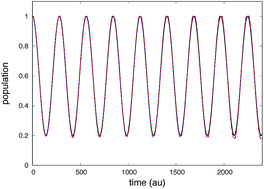Classical and nonclassical effects in surface hopping methodology for simulating coupled electronic-nuclear dynamics
Abstract
In this paper, we analyze the detailed quantum-classical behavior of two alternative approaches to simulating molecular dynamics with electronic transitions: the popular fewest switches surface hopping (FSSH) method, introduced by Tully in 1990 [Tully, J. Chem. Phys., 1990, 93, 1061] and our recently developed quantum trajectory surface hopping (QTSH) method [Martens, J. Phys. Chem. A, 2019, 123, 1110]. Both approaches employ an independent ensemble of trajectories that undergo stochastic transitions between electronic surfaces. The methods differ in their treatment of energy conservation, with FSSH imposing conservation of the classical kinetic plus potential energy by rescaling the classical momentum when a surface hop occurs while QTSH incorporates a quantum force throughout the dynamics which leads naturally to the conservation of the full quantum-classical energy. We investigate the population transfer and energy budget of the surface hopping methods for several simple model systems and compare with exact quantum results. In addition, the detailed dynamics of the trajectory ensembles in phase space are compared with the quantum evolution in the Wigner representation. Conclusions are drawn.

- This article is part of the themed collection: Quantum effects in complex systems


 Please wait while we load your content...
Please wait while we load your content...